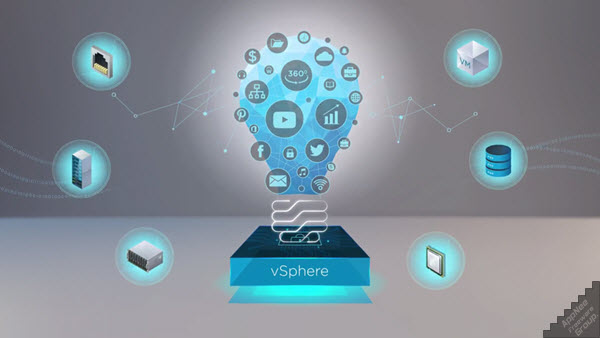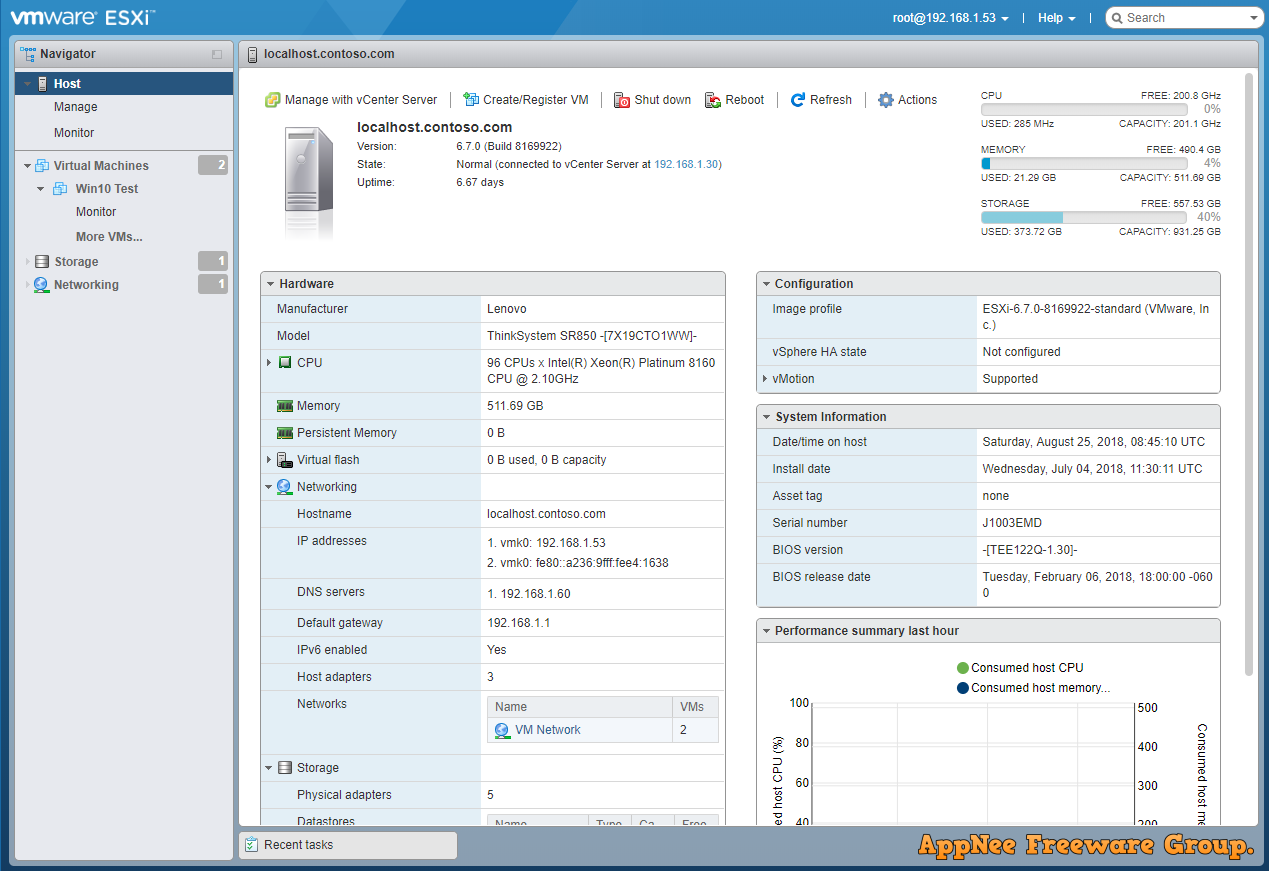| Ⅰ | This article along with all titles and tags are the original content of AppNee. All rights reserved. To repost or reproduce, you must add an explicit footnote along with the URL to this article! |
| Ⅱ | Any manual or automated whole-website collecting/crawling behaviors are strictly prohibited. |
| Ⅲ | Any resources shared on AppNee are limited to personal study and research only, any form of commercial behaviors are strictly prohibited. Otherwise, you may receive a variety of copyright complaints and have to deal with them by yourself. |
| Ⅳ | Before using (especially downloading) any resources shared by AppNee, please first go to read our F.A.Q. page more or less. Otherwise, please bear all the consequences by yourself. |
| This work is licensed under a Creative Commons Attribution-NonCommercial-ShareAlike 4.0 International License. |

VMware vSphere (formerly VMware Infrastructure 4) is currently the world’s leading server virtualization solution (including a series of products, of which ESXi and vCenter Server are used a lot), also the most stable and reliable cloud computing virtualization platform, developed by VMware. It can separate applications and operating systems from the underlying hardware, so as to simplify IT operations.
The core of VMware vSphere products suite is the virtual machine hypervisor VMware ESXi – the foundation on which other products rely. VMkernel provides CPU scheduling, memory management, and data processing for virtual exchange, so as to manage virtual machine to access the underlying physical hardware. vCenter Server can configure and centrally manage virtual machines, such as creating virtual machine templates, customizing virtual machines, and rapid allocation and deployment of virtual machines. In addition, VMware vSphere also provides features such as vSphere vMotion, vSphere Distributed Resource Scheduler (DRS), and more.

Similar to Citrix’s XenServer, ESXi is a powerful virtual system that can be installed and run independently on a single host, also one of the platforms frequently used for server virtualization. Unlike other VMware Workstation software that we have seen before, it is no longer dependent on the host operating system. After ESXi is installed, we can establish remote connection and control via vSphere Client, then create multiple VMS (virtual machines) on the ESXi server, then install Linux/Windows Server OS on these virtual machines to turn them into virtual servers that can provide various network application services. In addition, ESXi also supports hardware virtualization at the kernel level, so the virtual servers running on it are as good as the ordinary hardware servers in terms of performance and stability, yet much easier to manage and maintain.
Before VMware vSphere came along, servers were structured like this: Only one operating system could be installed on a server. If the OS is Windows, and it uses only about 10% of the server resources, then the idle resources are not available to other operating systems. If it is used as a browser server, and we need an additional client server, then you will have to buy another server to do this. This has undoubtedly resulted in a huge waste of resources and increased costs. With VMware vSphere, the architecture of a server can look like this: It realizes the allocation of the underlying hardware resources of a physical server, making it possible to set up and run multiple operating systems on the same server.

// Main Applications //
| Data Center Consolidation and Business Continuity |
| Simplify data center operations and management at scale, increase business efficiency, and decrease CapEx and OpEx through virtualization. |
| Enhanced App Performance and Hybrid Cloud |
| Take advantage of the latest innovations in hardware to turbocharge the performance of existing applications. Support new workloads and use cases, such as machine learning and artificial intelligence. Balance workloads and prioritize resources to ensure top performance for your critical applications. Extend on-premises environments to vSphere-based public clouds, such as VMware Cloud on AWS, and enjoy a streamlined hybrid cloud experience. |
| Virtualized Big Data |
| Simplify your big data infrastructure management while making it more cost effective. VMware is the best platform for big data just as it is for traditional applications. Minimize downtime with uniform, cost-effective failover protection; easily organize, prioritize, and share data center resources; and provision virtual networking across multiple hosts and clusters from a centralized interface. |
| Legacy Unix to Virtual Linux Migration |
| Get high performance, enhanced availability, larger VM capacity, and disaster recovery capabilities when you migrate legacy Unix infrastructure to virtualized Linux. Move an entire running virtual machine from one physical server to another, without downtime, and gain rich troubleshooting capabilities, including rollback and recovery for patching and updating. |
| Application and Infrastructure Security |
| Secure applications, infrastructure, data, and access with a comprehensive, built-in architecture and a simple, policy-driven model. Protect apps running on vSphere using machine learning and behavioral analytics to monitor threats and automate responses. Get faster visibility and protection with a scalable solution, no agents to manage, and minimal overhead. |
| Containerized Modern Apps |
| Bridge the gap between IT and developers with vSphere Integrated Containers. Leveraging the core capabilities of vSphere, your IT teams can run both traditional and containerized applications side by side on the same infrastructure, without the need for additional tooling or training. |
| Support for Remote Offices and Branch Offices |
| Manage your remote and branch offices with little or no local IT staff. Enable rapid provisioning of servers through virtualization, minimization of host configuration drift, and enhanced visibility into regulatory compliance across multiple sites. |
// Contained Components //
- VMware vSphere
- VMware vCloud
- VMware vSphere with Operations Management
- VMware vSphere Enterprise
- VMware vSphere Standard
- VMware vSphere Essentials
// Official Demo Video //
// Universal License Keys //
| Product | License Key |
| for v6.x | |
| VMware vSphere 6 Hypervisor |
|
| VMware vSphere 6 Hypervisor for Embedded OEMs |
|
| VMware vSphere 6 Desktop Host |
|
| VMware vSphere 6 for vCloud Service Provider Standard |
|
| VMware vCloud Suite 6 Standard |
|
| VMware vCloud Suite 6 Advanced |
|
| VMware vCloud Suite 6 Enterprise |
|
| VMware vSphere with Operations Management 6 Standard |
|
| VMware vSphere with Operations Management 6 Advanced |
|
| VMware vSphere with Operations Management 6 Enterprise |
|
| VMware vSphere 6 Foundation |
|
| VMware vSphere 6 for Embedded OEMs |
|
| VMware vSphere 6 Embedded Essentials |
|
| VMware vSphere 6 Embedded Foundation |
|
| VMware vSphere 6 Essentials |
|
| VMware vSphere 6 for Retail and Branch Offices |
|
| VMware vSphere 6 Essentials Plus |
|
| VMware vSphere 6 Essentials Plus for Retail and Branch Offices |
|
| VMware vSphere 6 Standard |
|
| VMware vSphere 6 Standard for Embedded OEMs |
|
| VMware vSphere 6 Enterprise |
|
| VMware vSphere 6 Enterprise for Embedded OEMs |
|
| VMware vSphere 6 Enterprise Plus |
|
| VMware vSphere 6 Enterprise Plus for Embedded OEMs |
|
| VMware vCenter Server 6 Essentials |
|
| VMware vCenter Server 6 Foundation |
|
| VMware vCenter Server 6 Standard |
|
| VMware vCenter Server 6 Standard for Embedded OEMs |
|
| Virtual SAN Standard |
|
| Virtual SAN |
|
| Virtual SAN for Desktop |
|
| for v7.x | |
| VMware vSphere 7 Hypervisor |
|
| VMware vSphere 7 Desktop Host |
|
| VMware vSphere 7 for vCloud Service Provider Standard |
|
| VMware vSphere 7 Foundation |
|
| VMware vSphere 7 Embedded Essentials |
|
| VMware vSphere 7 Embedded Foundation |
|
| VMware vSphere 7 Essentials |
|
| VMware vSphere 7 Essentials Plus |
|
| VMware vSphere 7 Standard |
|
| VMware vSphere 7 Enterprise |
|
| VMware vSphere 7 Enterprise Plus |
|
| VMware vSphere 7 Enterprise Plus with Add-on for Kubernetes |
|
| VMware vSphere 7 Scale-Out |
|
| VMware vCenter Server 7 Essentials |
|
| VMware vCenter Server 7 Foundation |
|
| VMware vCenter Server 7 Standard |
|
| VMware vSAN Standard |
|
| VMware vSAN Standard for Desktop |
|
| VMware vSAN Advanced |
|
| VMware vSAN Advanced for Desktop |
|
| VMware vSAN Enterprise |
|
| VMware vSAN Enterprise for Desktop |
|
| VMware vSAN Enterprise Plus |
|
| VMware vRealize Automation Enterprise |
|
| VMware vRealize Log Insight |
|
| VMware vRealize Network Insight |
|
| VMware vRealize Operations Manager 7 Enterprise |
|
// Edition Statement //
AppNee provides the VMware vSphere multilingual full installers and all versions universal license keys for Windows 32-bit and 64-bit.
// Installation Notes //
- Download and install your desired VMware vSphere products from official site
- Use the corresponding license key above to register program
- Done
// Prompts //
- Starting with version 6.5, VMware ESXi no longer supports vSphere Client to manage virtual machines. Instead, it starts to use the Web approach to manage.
// Download URLs //
| Product | Version | Download | Size |
| VMware vSphere | v6.7 |  |
n/a |
| VMware vCloud Suite |  |
n/a | |
| VMware vCenter Server |  |
n/a | |
| VMware vSAN |  |
n/a | |
| All Products | v7.0 |  (torrent) (torrent) |
206 GB |
| v8.0 |  (torrent) (torrent) |
249 GB |
(Homepage)
| If some download link is missing, and you do need it, just please send an email (along with post link and missing link) to remind us to reupload the missing file for you. And, give us some time to respond. | |
| If there is a password for an archive, it should be "appnee.com". | |
| Most of the reserved downloads (including the 32-bit version) can be requested to reupload via email. |